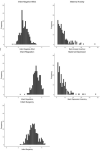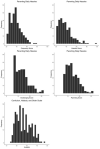Study Protocol: Longitudinal Attention and Temperament Study
- PMID: 34168577
- PMCID: PMC8218812
- DOI: 10.3389/fpsyt.2021.656958
Study Protocol: Longitudinal Attention and Temperament Study
Abstract
Background: Attention processes may play a central role in shaping trajectories of socioemotional development. Individuals who are clinically anxious or have high levels of trait anxiety sometimes show attention biases to threat. There is emerging evidence that young children also demonstrate a link between attention bias to salient stimuli and broad socioemotional profiles. However, we do not have a systematic and comprehensive assessment of how attention biases, and associated neural and behavioral correlates, emerge and change from infancy through toddlerhood. This paper describes the Longitudinal Attention and Temperament study (LAnTs), which is designed to target these open questions. Method: The current study examines core components of attention across the first 2 years of life, as well as measures of temperament, parental psychosocial functioning, and biological markers of emotion regulation and anxiety risk. The demographically diverse sample (N = 357) was recruited from the area surrounding State College, PA, Harrisburg, PA, and Newark, NJ. Infants and parents are assessed at 4, 8, 12, 18, and 24 months. Assessments include repeated measures of attention bias (via eye-tracking) in both infants and parents, and measures of temperament (reactivity, negative affect), parental traits (e.g., anxiety and depression), biological markers (electrophysiology, EEG, and respiratory sinus arrythmia, RSA), and the environment (geocoding, neighborhood characteristics, perceived stress). Outcomes include temperamental behavioral inhibition, social behavior, early symptom profiles, and cellular aging (e.g., telomere length). Discussion: This multi-method study aims to identify biomarkers and behavioral indicators of attentional and socioemotional trajectories. The current study brought together innovative measurement techniques to capture the earliest mechanisms that may be causally linked to a pervasive set of problem behaviors. The analyses the emerge from the study will address important questions of socioemotional development and help shape future research. Analyses systematically assessing attention bias patterns, as well as socioemotional profiles, will allow us to delineate the time course of any emerging interrelations. Finally, this study is the first to directly assess competing models of the role attention may play in socioemotional development in the first years of life.
Keywords: EEG; anxiety; attention; eye-tracking; infancy; longitudinal; temperament.
Copyright © 2021 Pérez-Edgar, LoBue, Buss, Field and the LAnTs Team.
Conflict of interest statement
The authors declare that the research was conducted in the absence of any commercial or financial relationships that could be construed as a potential conflict of interest.
Figures





References
-
- Rothbart MK, Posner MI, Rosicky J. Orienting in normal and pathological development. Dev Psychopathol. (1994) 6:635–52. 10.1017/S0954579400004715 - DOI
-
- Pérez-Edgar K. Attention mechanisms in behavioral inhibition: exploring and exploiting the environment. In: Pérez-Edgar K, Fox NA. editors. Behavioral Inhibition. Cham: Springer; (2018). p. 237–61.
-
- Fox NA, Hane AA, Pine DS. Plasticity for affective neurocircuitry: how the environment affects gene expression. Curr Direct Psychol Sci. (2007) 16:1–5. 10.1111/j.1467-8721.2007.00464.x - DOI
LinkOut - more resources
Full Text Sources

